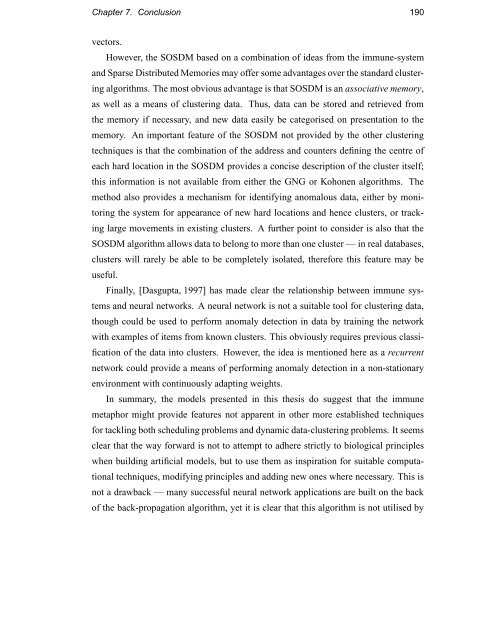Immunology as a Metaphor for Computational ... - Napier University
Immunology as a Metaphor for Computational ... - Napier University
Immunology as a Metaphor for Computational ... - Napier University
Create successful ePaper yourself
Turn your PDF publications into a flip-book with our unique Google optimized e-Paper software.
Chapter 7. Conclusion 190vectors.However, the SOSDM b<strong>as</strong>ed on a combination of ide<strong>as</strong> from the immune-systemand Sparse Distributed Memories may offer some advantages over the standard clusteringalgorithms. The most obvious advantage is that SOSDM is an <strong>as</strong>sociative memory,<strong>as</strong> well <strong>as</strong> a means of clustering data. Thus, data can be stored and retrieved fromthe memory if necessary, and new data e<strong>as</strong>ily be categorised on presentation to thememory. An important feature of the SOSDM not provided by the other clusteringtechniques is that the combination of the address and counters defining the centre ofeach hard location in the SOSDM provides a concise description of the cluster itself;this in<strong>for</strong>mation is not available from either the GNG or Kohonen algorithms. Themethod also provides a mechanism <strong>for</strong> identifying anomalous data, either by monitoringthe system <strong>for</strong> appearance of new hard locations and hence clusters, or trackinglarge movements in existing clusters. A further point to consider is also that theSOSDM algorithm allows data to belong to more than one cluster — in real datab<strong>as</strong>es,clusters will rarely be able to be completely isolated, there<strong>for</strong>e this feature may beuseful.Finally, [D<strong>as</strong>gupta, 1997] h<strong>as</strong> made clear the relationship between immune systemsand neural networks. A neural network is not a suitable tool <strong>for</strong> clustering data,though could be used to per<strong>for</strong>m anomaly detection in data by training the networkwith examples of items from known clusters. This obviously requires previous cl<strong>as</strong>sificationof the data into clusters. However, the idea is mentioned here <strong>as</strong> a recurrentnetwork could provide a means of per<strong>for</strong>ming anomaly detection in a non-stationaryenvironment with continuously adapting weights.In summary, the models presented in this thesis do suggest that the immunemetaphor might provide features not apparent in other more established techniques<strong>for</strong> tackling both scheduling problems and dynamic data-clustering problems. It seemsclear that the way <strong>for</strong>ward is not to attempt to adhere strictly to biological principleswhen building artificial models, but to use them <strong>as</strong> inspiration <strong>for</strong> suitable computationaltechniques, modifying principles and adding new ones where necessary. This isnot a drawback — many successful neural network applications are built on the backof the back-propagation algorithm, yet it is clear that this algorithm is not utilised by









![Unit 5. Switches and VLANs [PDF]](https://img.yumpu.com/34422504/1/184x260/unit-5-switches-and-vlans-pdf.jpg?quality=85)






